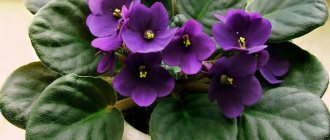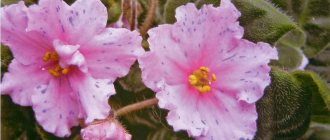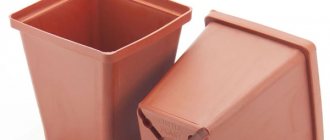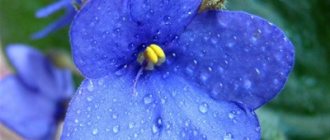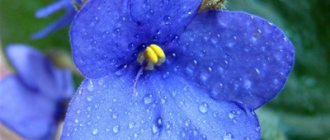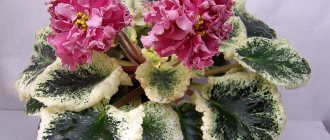Indoor violet is considered one of the most popular plants among gardeners. Delicate flowers leave no one indifferent, and a huge number of varieties and hybrids force Saintpaulia fans to purchase new specimens. The violet, the history of the origin of the flower and its structure deserve special attention. No less interesting are some historical facts about the plant, as well as signs and superstitions associated with it.
History of the origin of violets
Violet is an annual or perennial plant with dense double leaves and small inflorescences. Breeders have obtained a large number of varieties and hybrids that differ in bud color and size. However, the main advantage of the plant is its ability to flower. Violet blooms for a long period - up to 9 months, and the time of year does not affect this process.
Legends associated with violets
There are many legends and beliefs associated with Saintpaulia that explain its origin. Ancient Greek myths tell the story of the violet flower. Once Apollo incinerated a gentle nymph with his hot rays. The girl had to ask for protection from the powerful Zeus. He took pity and turned her into a beautiful violet, hiding her from the sun's rays in the thickets of the forest. He hid the beauty so that no one could see or admire her.
This continued until Persephone discovered the flower. She picked the bouquet. On the way back, Hades stole her. Persephone got scared and dropped the flowers. They woke up from Olympus to earth.
History of appearance in Russia
The history of the appearance of indoor violets in our country began with the appearance of the flower in Europe. In 1893 it was first introduced in Germany. In Russia, people learned about this unique flower in the middle of the 20th century. The largest collection of wild and selected specimens was collected by employees of Leningrad State University. Later, in 1962, the Makuni family began breeding and collecting violets. The couple has been breeding Saintpaulias for more than 30 years. During this period, they were able to breed over a hundred species.
Homeland of the flower
Saintpaulia's homeland is Africa, but it is difficult to name the exact place. It was first found in Tanzania. More often the flower can be found in Japan, the Andes, and northern America. Some species inhabit the subtropical regions of Brazil and South Africa. Saintpaulia also grows in New Zealand, in Europe, and in Russia it is found in the southern regions of Siberia. Any species in its natural habitat prefers open, slightly shaded areas of a temperate climate. For proper growth and development of the plant, a humid climate is required.
Biological classification
Species are combined into a separate genus. They belong to the herbaceous plants of the Gesneriaceae family. Based on the structure of the plant, violet is classified as follows:
- kingdom - plants;
- department – flowering;
- class – double-field;
- order – clear-flowered;
- family - Gesneriaceae;
- genus - Saintpaulia.
Other types of classification include characteristics based on the size of the rosette, the shape of the flower, the shades of the buds, the color and shape of the leaf blade.
Interesting Facts
Few people know that the popular flower has found its use in cooking. In addition, it has long been used in traditional and folk medicine.
Use in cooking
The low calorie content of dishes using the plant allows you to enjoy the unusual taste and will help you maintain your figure. Candied spiced flower petals, packed in boxes with the image of Empress Elisabeth of Bavaria, are a flower dessert that is a souvenir calling card of the capital of Austria - Vienna.
There are unusual dishes with flowers of a beautiful plant: pastries, drinks, desserts. The most common:
- violet cake;
- dessert “violet tenderness”;
- violet cocktail;
- Everyone's favorite treat is ice cream.
Structure
Saintpaulia has a completely recognizable appearance. It cannot be confused with another indoor plant. The size is small, elastic leaves tightly cover the pot. The buds of the plant are small, growing above the leaf blade.
Saintpaulia has a tap root system. The roots are thin and easily damaged by careless manipulation. Flower growers should be aware that the root system of the plant develops quickly and deprives the soil of useful components. It is for this reason that Saintpaulia must be replanted annually. In addition to the root system, the parts of the violet plant include the stem, shoot, and flower.
Stem structure
The structure of the violet stem is unique. The plant is characterized by a low stem with a lush rosette of leaves in the root area. The leaf blades are rich green in color with abundant pubescence on the surface. They are quite wide and shaped like hearts. The edges of the leaf blade may be wavy. It is noteworthy that the shade of the leaf depends on gender. The structure of the violet leaf is characterized by the presence of short petioles and stipules.
Escape structure
The structure of the violet shoot does not have any special features. There are one to several flowers on the shoot. In addition to flowers, the peduncle has bracts. The process of reproduction directly depends on them. The more developed they are, the more suitable this peduncle is for reproduction.
Flower structure
The structure of a violet flower is classic: petals, pistil and stamens. In this case, the petals play a more decorative role. In natural wild conditions, they attract large numbers of insects for the pollination procedure. The pistil and stamens are involved in the fertilization process during breeding work. In turn, stamens have anthers and filaments.
Abstract of the GCD “Indoor plants. Violet is our friend" for children of the middle group.
Elena Kuchina
Abstract of the GCD “Indoor plants. Violet is our friend" for children of the middle group.
Goal: Formation of labor skills in children in caring for indoor plants .
1. Maintain children's interest in indoor plants , show new ways to care for them (treating leaves with a brush, watering plants in a tray ).
2. Encourage children to use words: care, water, spray, loosen, leaves, stem, flower, root.
3. Strengthen children’s to make a whole from parts.
4. Cultivate a love for indoor plants , see their beauty and benefits.
How do plants reproduce?
Care and propagation vary depending on the specific variety. For the horned violet species, growing from seeds will be most relevant; the rest are best propagated using leaves and cuttings.
In the first case, you need to carefully examine the leaves. If you see thrips on violets, the leaves are definitely not suitable - look for exclusively healthy parts. Carefully cut the leaf and place it in a container with a nutrient substrate. Then place in a plastic bag and close tightly. An artificially created greenhouse effect will provide the plant with the required amount of moisture.
https://www.youtube.com/watch?v=wovhgipdbrs
And there is a second, simpler method of propagation by leaves. Find a good, healthy leaf, like in the photo, place it in a glass of water and wait for roots to form. As soon as they reach a length of 1 cm, the plant is planted in a pot.
You may have probably seen in photos or other articles that seeds are used to propagate flowers. It is worth noting that this method is quite complex, because the seeds need to be collected, the necessary conditions for growth must be created, planted and replanted correctly. Therefore, we recommend that you choose leaf propagation as a simpler and more affordable method.
Energy influence and superstitions
A description of indoor violets will be incomplete without mentioning their energy component. Violets are very sensitive not only to drafts from the window, but also to bad energy in the house.
In homes where there is a lot of arguing and family members suffer from mood swings and depression, violets usually bloom poorly and tend to disappear.
Attention! The zodiac sign that violet corresponds to is Taurus. Like this sign, Saintpaulias symbolize harmony, stability and tranquility.
Violet brings peace and harmony to the house, cleanses the space of negativity. By bringing wealth into the home, it improves health and extends life expectancy.
The energy of plants depends partly on their color:
- white - purity, femininity, peace, tranquility, liberation from oppression.
This color is suitable for calming, both for people in a state of aggression and for those who are emotionally very sensitive. Dulling the feeling of anger, worries and fears, communication with a white violet brings peace. It is recommended to place white violets in rooms where children live, especially if quarrels often arise between them; - red of all shades - cleanse the house of negative energy, treat depression, and help pessimists. A person who has a violet of these colors in his house begins to have a more positive attitude towards his life;
- blue and blue - personify the unification of the earthly and airy, awakens creative abilities. They are often placed in the rooms of children who are trying to teach art - music, singing, drawing. Blue color also reduces appetite, and it is useful to place them in the kitchen if you want to lose weight;
- purple - helps mutual understanding, comprehension of the spiritual, wise, as well as for meditation and reading the future. They are hosted by teachers, writers, psychologists, philosophers and thinkers.
We suggest you familiarize yourself with why violet leaves turn yellow, problems, pests, diseases
Features of Saintpaulia, its appearance
You already know that the birthplace of violets is Africa. Saintpaulia is a perennial plant up to 30 cm high. It has a short stem, large leaves, and an oval shape. Some types of violets have heart-shaped or elongated leaves. The color also differs - from light to dark green.
Visual photos confirm the incredible variety of colors and shapes. You can find a flower with double, corrugated, wavy or fringed petals. The average diameter is 2-4 cm, both single-color and multi-color colors are found. Night violet and Labrador violet, swamp violet and butterfly violet... It seems as if all these varieties are competing with each other in beauty.
Previously, indoor Saintpaulia had no smell and pleased gardeners solely with its appearance. As a result of long and painstaking breeding work, hybrids with a subtle, very pleasant aroma were bred.
Soil preparation for Saintpaulia and watering features
Perennial violet is planted in plastic pots with a diameter of 5 to 9 cm. Due to the root system of a superficial type, it is recommended to give preference to flat pots. Loose soil that absorbs water well and allows air to pass through is suitable. The store sells a ready-made base, although you can prepare it yourself.
Be sure to run hot water over the pot before filling it with soil. This will destroy harmful microbes.
In order for the night violet to bloom profusely, as in the photo, it needs to be periodically fed with fertilizers. You can mix them directly into the soil or dilute them with water for complex watering. In the second case, the concentration decreases by 6-7 times. This will prevent the plant from burning.
Also make sure that the vetch and garden violet are not covered with white dust. This deprives the flower of its aesthetics and prevents it from developing and breathing normally.
To prevent white dust from appearing, night violet and viola are watered with warm water twice a month. It is advisable to immediately cover the soil with paper or polyethylene. It is recommended to carry out water procedures in the evening or early in the morning. The plant will be able to dry out before the first rays of the sun touch it.
For watering, use tap water, previously brought to a boil and cooled.


